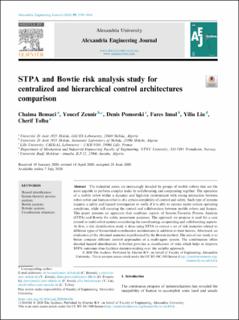| dc.contributor.author | Bensaci, Chaima | |
| dc.contributor.author | Zennir, Youcef | |
| dc.contributor.author | Pomorski, Denis | |
| dc.contributor.author | Innal, Fares | |
| dc.contributor.author | Liu, Yiliu | |
| dc.contributor.author | Tolba, Cherif | |
| dc.date.accessioned | 2021-02-19T07:08:32Z | |
| dc.date.available | 2021-02-19T07:08:32Z | |
| dc.date.created | 2021-01-11T10:14:42Z | |
| dc.date.issued | 2020 | |
| dc.identifier.citation | Alexandria Engineering Journal. 2020, 59 (5), 3799-3816. | en_US |
| dc.identifier.issn | 1110-0168 | |
| dc.identifier.uri | https://hdl.handle.net/11250/2729053 | |
| dc.description.abstract | The industrial zones are increasingly invaded by groups of mobile robots that are the most capable to perform complex tasks by collaborating and cooperating together. The operation of a mobile robot within a dynamic and high-risk environment with strong interaction between robot-robot and human-robot is of a certain complexity of control and safety. Such type of systems requires a safety and hazard investigation to verify if it is able to operate under certain operating conditions, while still ensuring the control and collaboration between mobile robots and human. This paper presents an approach that combines aspects of System-Theoretic Process Analysis (STPA) and Bowtie for safety assessment purposes. The approach we propose is used for a case related to multi-robot systems considering the coordinating, cooperating and collaborating aspects. At first, a risk identification study is done using STPA to extract a set of risk scenarios related to different types of hierarchical coordination architectures in addition to their factors. Afterward, an evaluation of the obtained scenarios is performed by the Bowtie method. The aim of our study is to better compare different control approaches of a multi-agent system. The combination offers detailed hazard identification. It further provides a classification of risks which helps to improve STPA outcomes thus facilitate decision-making over the suitable approach. | en_US |
| dc.language.iso | eng | en_US |
| dc.publisher | Elsevier | en_US |
| dc.rights | Attribution-NonCommercial-NoDerivatives 4.0 Internasjonal | * |
| dc.rights.uri | http://creativecommons.org/licenses/by-nc-nd/4.0/deed.no | * |
| dc.title | STPA and Bowtie risk analysis study for centralized and hierarchical control architectures comparison | en_US |
| dc.type | Peer reviewed | en_US |
| dc.type | Journal article | en_US |
| dc.description.version | publishedVersion | en_US |
| dc.source.pagenumber | 3799-3816 | en_US |
| dc.source.volume | 59 | en_US |
| dc.source.journal | Alexandria Engineering Journal | en_US |
| dc.source.issue | 5 | en_US |
| dc.identifier.doi | https://doi.org/10.1016/j.aej.2020.06.036 | |
| dc.identifier.cristin | 1868639 | |
| dc.description.localcode | 2020 The Authors. Published by Elsevier B.V. on behalf of Faculty of Engineering, Alexandria University. This is an open access article under the CC BY-NC-ND license (http://creativecommons.org/licenses/by-nc-nd/4.0/). | en_US |
| cristin.ispublished | true | |
| cristin.fulltext | original | |
| cristin.qualitycode | 1 | |

